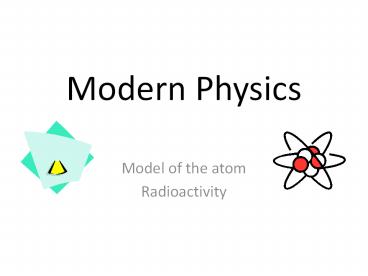Modern Physics - PowerPoint PPT Presentation
1 / 22
Title:
Modern Physics
Description:
Modern Physics Model of the atom Radioactivity Introduction - Today we expand our discussion of explaining what happens at the nuclear level atoms. – PowerPoint PPT presentation
Number of Views:320
Avg rating:3.0/5.0
Title: Modern Physics
1
Modern Physics
- Model of the atom
- Radioactivity
2
Introduction - Today we expand our discussion of
explaining what happens at the nuclear level
atoms.
- Radioactivity (substances that give of invisible
radiations) and the types of radiations. - What happens when an atom undergoes radioactivity
decay - Uses for radiation
- The types of reactions that cause nuclear
reactions - The affects of nuclear reactions on energy
3
Nucleons
- Are particles occupying the nucleus
- Consist of charged protons and neutral neutrons
- Have almost 2000 time the mass of electrons
- Are made of quarks and leptons (building blocks
of matter, elementary particles)
4
Atom
Atomic mass protons neutrons (number
of nucleons)
Atomic number number of protons
5
Isotopes
- Atoms of the same element with different numbers
of neutrons (different masses)
6
Radioactive Isotopes
- Has an unstable nucleus
- Spontaneously emits a particle and decay into
another element.
7
Marie Curie Nobel prize winner
- The word radioactivity was first used by Marie
Curie in 1898. - She used the word radioactivity to describe the
property of certain substances to give off
invisible radiations that could be detected by
films.
8
Radioactive Decay
- Three different kinds of radiation given off by
radioactive materials - Alpha rays
- Beta rays
- Gamma rays
- called rays because the radiation carried
energy and moved in straight lines, like light
rays.
9
- Radioactivity comes from the nucleus of the atom.
- If the nucleus has too many neutrons, or is
unstable the atom undergoes radioactive decay. - decay - to "break down."
10
Atomic Decay
- Alpha decay the nucleus ejects two protons and
two neutrons. - Beta decay a neutron in the nucleus splits into
a proton and an electron. - Gamma decay occurs because the nucleus is at too
high an energy. The nucleus falls down to a lower
energy state and, in the process, emits a high
energy photon.
11
- Radioactive decay gives off energy.
- The energy comes from the conversion of mass into
energy. - Because the speed of light (c) is such a large
number, a tiny bit of mass generates a huge
amount of energy. - Radioactivity occurs because everything in nature
tends to move toward lower energy.
12
Radiation
- The flow of energy through space.
- Forms of radiation
- Light
- Radio
- Microwaves
- X-rays
- Many people mistakenly think of radiation as only
associated with nuclear reactions.
13
X-ray machines
- X-rays are photons
- Used to produce images of bones and teeth on
x-ray film. - X-ray film turns black when exposed to x-rays.
14
X-Rays Uses
- High level therapeutic x-rays are used to
destroy diseased tissue, such as cancer cells. - The beams are made to overlap at the place where
the doctor wants to destroy diseased cells.
15
CAT scan
- Computerized Axial Tomography
- Produced by a computer that controls an x-ray
machine as it takes pictures of the body from
different angles. - Produces three-dimensional images of bones and
other structures within the body.
16
Radiation Detection
- The Geiger counter is a type of radiation
detector invented to tell when radiation is
present and to measure its intensity.
17
Half-life
- The time it takes for half the mass of a
radioactive sample to decay. - Ranges from a fraction of a second to billions of
years. - Is not affected by external conditions.
18
Fusion reactions
- Nuclear reaction that combines, or fuses, two
smaller nuclei into a larger nucleus. - It is difficult to make fusion reactions occur
because positively charged nuclei repel each
other.
19
Fission reactions
- A fission reaction splits up a large nucleus into
smaller pieces. - A fission reaction typically happens when a
neutron hits a nucleus with enough energy to make
the nucleus unstable.
20
Nuclear Reactions and Energy
- A nuclear reaction is any process that changes
the nucleus of an atom. - Radioactive decay is one form of nuclear reaction.
21
Nuclear Reactions and Energy
- If you could take apart a nucleus and separate
all of its protons and neutrons, the separated
protons and neutrons would have more mass than
the nucleus did. - The mass of a nucleus is reduced by the energy
that is released when the nucleus comes together. - Nuclear reactions can convert mass into energy.
22
Nuclear Reactions and Energy
- Both these nuclear reactions release a small
portion of the mass as large amounts of energy. - Nuclear fusion is what powers a modern nuclear
warhead (hydrogen bomb) - Nuclear fission (less powerful) occurs in an
atomic bomb (like the ones used against Japan in
WWII), or in a nuclear power plant.






![Modern Physics [2] PowerPoint PPT Presentation](https://s3.amazonaws.com/images.powershow.com/8002705.th0.jpg?_=20160723081)
![L 36 Modern Physics [2] PowerPoint PPT Presentation](https://s3.amazonaws.com/images.powershow.com/7897333.th0.jpg?_=20210302064)
![L 34 Modern Physics [1] PowerPoint PPT Presentation](https://s3.amazonaws.com/images.powershow.com/7125701.th0.jpg?_=20150905079)
![L 35 Modern Physics [1] PowerPoint PPT Presentation](https://s3.amazonaws.com/images.powershow.com/7552279.th0.jpg?_=20160119094)
![L 37 Modern Physics [3] PowerPoint PPT Presentation](https://s3.amazonaws.com/images.powershow.com/7727835.th0.jpg?_=20160405031)
![L 38 Modern Physics [3] PowerPoint PPT Presentation](https://s3.amazonaws.com/images.powershow.com/8065013.th0.jpg?_=20160820129)
![L 33 Modern Physics [1] PowerPoint PPT Presentation](https://s3.amazonaws.com/images.powershow.com/7602675.th0.jpg?_=201602121011)


















